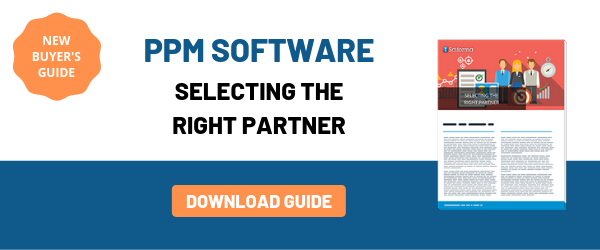Are you a PMO or has your company just established a project management office? Would you like to improve your project portfolio management? In this blog post, we give you 5 PPM tips to improve your project portfolios.
Tip #1 to Improve Your Project Portfolio Management: Define your PPM KPIs and establish your portfolio dashboard
A project portfolio is a collection of projects that meet their own objectives and progress at different rates. To get an overview of all your projects and see how you can react quickly, it’s essential to set up a dashboard. You can easily anticipate budget overruns, delays and risks.
Each project manager remains master of his projects but you will be able to detect problems more easily and react in time. It’s important to define the KPIs for your portfolio dashboard and ensure your projects align with the company goals: budget overruns, resource allocation, deadlines. You can even set a health score to evaluate the status of your projects with a single indicator.
Tip #2: Create a culture of prioritization within the company
As PMO, it’s your responsibility to prioritize the company’s projects. By putting in place uniform evaluation methods, you can select the projects bringing the most value based on the company’s overall strategy.
For effective portfolio management, the process itself must be deeply rooted and prioritized in a consistent manner throughout the organization. From the leaders to the members of the project, all the actors must think in terms of priorities. Thus, you make sure that everyone moves in the same direction and limit the drifts.
Tip #3 for Improved PPM: Choose to hire PPM and project management experts
To improve your project portfolio management, you need to make an accurate inventory of the resources and skills within your company. Get better visibility of the projects that you can actually achieve versus those likely to fall behind due to lack of expertise.
Therefore allocations should be prioritized on the basis of experience and skills rather than availability. You will save time on completing the tasks. This also means that the organization needs to invest in talent with any missing skills.
Tip #4: Do micro-monitoring rather than micro-management
As a PMO, you can easily get dragged into micro-management because you will get a sense of involvement and control over project progress. But be careful not to lose sight of your mission, which is to follow your portfolio and ensure its strategic aligned with the objectives of the company. This isn’t only a bad use of your time but you will also duplicate the work of project managers.
By doing micro-monitoring, you will pay attention to important indicators with the appropriate level of involvement. It is important to understand the difference between vigilance and interference to be ready to react only when necessary.
Find out more about micro-management, read this article by Mark A. Langley, CEO of PMI.
Tip #5: Use the right methods and tools for project portfolio management
The best way to optimize your project portfolio management is to use the right tools and adopt the best practices (for this please consult our guide on project and portfolio management fundamentals). To save time, implement a portfolio management software such as Sciforma. You will simplify execution and monitoring by centralizing information and improving communication. At a glance, you will have an overall view of the state of your portfolio and can make informed decisions based on the data.
Along with this, you will also need to establish a set of practices to achieve your strategic goals. The standardization of portfolio management is an essential step to improve efficiency within the organization.
To go further, consult our evaluation grid to choose the best project management tool.
Are you looking for a portfolio management software? Read the complete Buyer’s Guide eBook : Selecting the Right Partner.







Camélia Docquin
Camélia is Sciforma’s Global Marketing Director and enjoys learning different perspectives of the current business environment and project management challenges that enterprises and individuals face daily. Main interests include : innovation, digital transformation, and strategy execution.